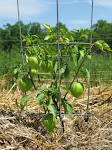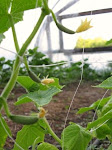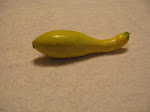
Lakes and Valley CSA news
June 27, 2008
In your veggie boxes next week (June 30th for PR and DL, July 3 for Fargo/Dilworth):
Spinach
Chinese cabbage
Radishes
Looseleaf head lettuce
Mesclun with edible flowers
Pac choi, Waido and Bonsai Asian greens
Arugula
Eggs
Russian tarragon herb
The first three CSA deliveries always feature greens. The peas, zucchini and cucumbers are still in their infant stage (see attached photo), but the greens, light and cleansing, are in their prime.
The loosehead lettuces you are about to eat are never found in a supermarket. They are far too fragile to pack and ship commercially. Green oakleafs like Berenice and Galisse, red oakleafs named Oscarde and Ferrri, cos lettuce called Eruption and Jericho, Adriana and Asutrale butterheads, Deer Tongue Bibb, and Buttercrunch. Each head is cut at ground level, carried by hand to a washing table, then sprayed with a soft shower of cold water. Dunking in a vat knocks off too many leaves, so we’ll leave the final rinsing to you. Separate the heads, swish individual leaves in a sink or bowl of cold water to remove trapped sand and soil. Store in a sealed plastic bag if you spin dry the lettuce, or a vented bag if you don’t have time to drip dry.
Meslcun means “mix” in French. Your bag of mesclun mix contains baby green and red lettuces picked hours before the sun rises over the trees on the east side of the garden. Colors vary and mingle, flavors blend and stand out. We cut each leaf with shears, plunge into a tub of ice-cold water, then spin dry. Flavor, beauty and vitality in a bag. Varieties include Outredgeous, Tango, Lollo Rossa, Saladbowl, Royal Oak, Firecracker and Parris Island. Meslcun 1 is in the foreground of the photo of Ken wheel-hoeing jauntily.
I hunger for fresh greens until the first harvest day. How could I not? The taste of truly fresh is impossible to recreate at any other time of the year. I celebrate by dressing my first salad of the season with a simple vinaigrette. Then I start experimenting.
Classic Vinaigrette makes about ¼ cup
1 Tbsp. balsamic, herbal, raspberry, red wine, sherry or white wine vinegar
1 small garlic clove or 1 Tbsp minced fresh herbs
½ teaspoon Dijon mustard
3 Tbsp extra-virgin olive oil
salt and pepper
Mix together vinegar, garlic and mustard. Whisk until smooth. Slowly pour in the oil and whisk until the oil if fully incorporated. Season with salt and pepper. Use immediately.
Tahini dressing makes 1 ¼ cups
1 garlic clove
2/3 cup tahini
6 Tbsp fresh lemon juice (about 2 lemons)
2 Tbsp honey
½ cup water
Mince garlic in a food processor or blender. Add remaining ingredients and process until well blended. Season to taste with salt. Serve immediately, or store in an airtight jar in the refrigerator for up to a week. It will need remixing before serving.
Blue Cheese dressing makes about 1 cup
½ cup buttermilk
¼ cup crumbled Blue cheese
3 Tbsp mayonnaise
2 Tbsp fresh parsley
1 garlic clove
Combine all ingredients in a blender or food processor until thick and fairly smooth. Season to taste with salt and pepper. Keeps up to 5 days in the refrigerator.
Arugula is distinctively peppery. Deemed an aphrodisiac, it was banned from monastery gardens in the Middle Ages. Its small, lobed, deep green leaves can be eaten fresh, cooked in a stir-fry or made into pesto.
Arugula pesto
From the food network website
4 cups packed fresh arugula
1 tablespoon minced garlic
Salt and freshly ground pepper
1 cup pure olive oil
2 tablespoon pine nuts, toasted, plus 1 tablespoon
1/8 teaspoon vitamin C (optional)
1/2 cup freshly grated Parmesan
Prepare an ice water bath in a large bowl, and bring a large pot of water to a boil. Put the arugula in a large sieve and plunge it into the boiling water. Immediately immerse all the arugula and stir so that it blanches evenly. Blanch for about 15 seconds. Remove, shake off the excess water, then plunge the arugula into the ice water bath and stir again so it cools as fast as possible. Drain well.
Squeeze the water out of the arugula with your hands until very dry. Roughly chop the arugula and put in a blender. Add the garlic, salt and pepper to taste, olive oil, 2 tablespoons of the pine nuts, and the vitamin C, if using. Blend for at least 30 seconds. The green of the arugula will thoroughly color the oil. Add the cheese and pulse to combine. The pesto will keep several days in a tightly sealed container in the refrigerator.
Pull out before dinner to get to room temperature. Before serving, add the remaining 1 tablespoon toasted pinenuts.
The Chinese cabbages we are raising are Brassica rapa, specifically the Napa type. The heads are starting to wrap up but will not be fully formed by the first harvest. This in no way diminishes the crisp texture or juicy softness of the cabbages. Use as any cabbage, but slice instead of grating.
Napa Cabbage Salad serves 4
Prep and Cook Time: 15 minutes
Ingredients:
· 4 cups finely chopped napa cabbage
· ½ cup chopped scallion
· 1 medium tomato, seeds and excess pulp removed
· OPTIONAL: 1 cup chopped chicken breast
·
· Dressing
· 1 tsp grated fresh ginger
· 2 medium cloves garlic, pressed
· 1 TBS rice vinegar, or lemon juice
· 1 tsp honey
· 2 TBS soy sauce
· ¼ tsp dry mustard
· 1 TBS extra virgin olive oil
· salt and white pepper to taste
Directions:
Chop cabbage, scallion and place in a bowl. Cut tomato in half and squeeze out seeds, cut out pulp, and slice in thin strips.
Whisk together dressing ingredients and toss with cabbage, tomato, scallion, and optional chopped chicken. Sprinkle with sesame seeds.
Russian Tarragon is hardier and milder than its French cousin. Known as the “dragon herb” (A. dracunculiodes L.), its leaves are good in salads and cooked foods. Chop and add to soft butter or oil for flavorful cooking. Or dry by stripping the leaves off the stem and spreading out on a dishtowel or cookie sheet. When dry, crumble into an herb jar with tight-fitting lid.
Pac Choi and Waido greens make good stir fry. Chop as your other vegetables and sauté, adding thicker stems before the tender, fast-cooking leaves. Greens, onions, sprouts and dashes of tamari soy sauce served over brown or wild rice. Yum.
 We’ve spent many hours mulching the onions, tomatoes, melons, and winter squashes. Dewane sets big bales along side the rows and we unroll, carry sections in, and spread out. Mulching the spaces between the tomatoes, melons and squashes is good training for the onions, which were transplanted five inches apart in rows 12 inches apart. The best way to maneuver mulch around the onions is to form a 24-inch long roll of hay, slip it under the easily-damaged, tubular leaves with a sideways bowling motion, and then fan out the roll to shade the row. It took four people (thank you, Sari!) four itchy hours to mulch four beds of onions.
We’ve spent many hours mulching the onions, tomatoes, melons, and winter squashes. Dewane sets big bales along side the rows and we unroll, carry sections in, and spread out. Mulching the spaces between the tomatoes, melons and squashes is good training for the onions, which were transplanted five inches apart in rows 12 inches apart. The best way to maneuver mulch around the onions is to form a 24-inch long roll of hay, slip it under the easily-damaged, tubular leaves with a sideways bowling motion, and then fan out the roll to shade the row. It took four people (thank you, Sari!) four itchy hours to mulch four beds of onions. Despite two tractor cultivations, and three wheel-hoeings, weeds grow between plants in the rows. Hands and knees is kindest to our backs, so we crawl down the rows, our hands working like weed-eaters. Soon the cabbages and broccoli will canopy and shade the ground. The wheel-hoe slices an inch or two under the soil’s surface. This top layer dries out, creating a dust mulch that performs like straw or hay mulch, in that it keeps moisture in the soil and prevents weed seeds from germinating. We’ve not enough weathered hay and straw to cover the entire garden. This simple technique satisfies Nature’s mandate to nurture essential microbes in our topsoil, the ones that live symbiotically with the plant’s roots, digesting minerals into plant food. In dry years, it maximizes the conservation of water.
Despite two tractor cultivations, and three wheel-hoeings, weeds grow between plants in the rows. Hands and knees is kindest to our backs, so we crawl down the rows, our hands working like weed-eaters. Soon the cabbages and broccoli will canopy and shade the ground. The wheel-hoe slices an inch or two under the soil’s surface. This top layer dries out, creating a dust mulch that performs like straw or hay mulch, in that it keeps moisture in the soil and prevents weed seeds from germinating. We’ve not enough weathered hay and straw to cover the entire garden. This simple technique satisfies Nature’s mandate to nurture essential microbes in our topsoil, the ones that live symbiotically with the plant’s roots, digesting minerals into plant food. In dry years, it maximizes the conservation of water.And finally, just for fun, the faceless shot of our knees post-weeding. An hour or two after we finish, the accumulated soil falls off, leaving a dark patch on my pants. Good dirt, honest work. I can wear them tomorrow. We’ve not hand weeded the carrots yet.




